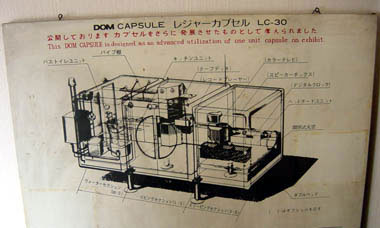Schwarz
View current page
...more recent posts

Kisho Kurokawa
Nakagin Capsule Tower
Tokyo, Japan
The Nakagin Capsule Tower was the first capsule architecture design, the capsule as a room inserted into a mega-structure, built for actual use.
The Capsule Tower realizes the ideas of metabolism, exchangeability, recycleablity as the prototype of sustainable architecture.

Even before Hurricane Katrina, Dr. Dawdy had found ways to return to New Orleans. In 2004, she made an intriguing discovery while researching a possible archaeological site under an old French Quarter parking garage slated for demolition. Property records and advertisements from the 1820's said that the site had been the location of a hotel with an enticing name: the Rising Sun Hotel.
This month, workers are dismantling a rare steel house built in Charlestown Township, Pa., in 1946, saving it from being demolished for a subdivision.
The pieces of the three-bedroom, 900-square-foot house will be stored until the Preservation Alliance for Greater Philadelphia, which raised the $20,000 to dismantle the structure, can find a new owner. The house is free to anyone who promises to rebuild it.
The Acropolis in Athens made it, as did Angkor Wat temple in Cambodia, China's Great Wall, the Colosseum in Rome, the Inca temple of Machu Picchu in Peru, Stonehenge and the Moai - the Easter Island statues.
Less immediately obvious choices in a final shortlist of 21 contenders for the New Seven Wonders of the World, announced in Switzerland yesterday, included the Kremlin in Moscow, the Eiffel Tower and the Statue of Liberty.
When the Ouroussoff article came out I had just made my second visit to the revamped MoMA. My first visit involved one of the many opening galas when, sometime late in the evening after several vodka and sodas, two self-proclaimed "bloggers" asked me how I liked the new building. I told them I loathed it. "What do you mean?" one sputtered. I couldn't articulate an answer, but what I meant is I hated the grandeur of the place, how much it seemed to celebrate not the art or the objects but the exalted cultural role of the institution.
On my second visit I made peace with the building. I still don't care for the bombast of the communal spaces, but I'm happy with the contents of many of the galleries, especially the smaller ones housing prints and drawings, architecture and design. Granted the design gallery is no longer a sparsely populated hideaway on the top floor of the museum. And I'm nostalgic about the days when I would have the collection all to myself, but the bigger, brighter space surely reflects the new status of design in American popular culture.
About that same time I was also thinking about how hard it is to mount a really innovative contemporary industrial-design show these days. The problem--and it's not specific to MoMA--is that the products one can find on the shelves of almost any store are likely to be as varied, sophisticated, and inventive as the objects a museum can pull together. Stores can change inventory faster and with much less planning than a curator burdened with two-year lead times. When I visit the Cooper-Hewitt now I spend more time in the shop than in the galleries. Director of retail Gregory Krum was once the product manager at Moss, a Soho design shop that appropriated the aesthetic of a museum design gallery. Because he is a merchant, Krum can put his ideas into action without sitting through countless committee meetings. As a result the store is generally a better place to view fresh design.
It may be true that talents like Ms. Hadid and Mr. Koolhaas have sucked some of the oxygen from members of a younger generation struggling to find their footing in a celebrity-driven profession. The jury is still out on that one. But either way, these buildings prove that architecture is in the midst of a renaissance. Whatever one imagines about the egos of their architects, these projects exude a social dynamism and freedom - a thriving democratic ideal.
What's more, such buildings force us to re-examine corners of Modernist history that once seemed relegated to the scrapheap. Their architects are clearly influenced by talents as far ranging as Kevin Roche, Hans Scharoun and Oswald Mathias Ungers, whose tough, sometimes brutal forms were once excluded from the Modernist canon.
The problem is how few people seem capable of such a generous view of history. Recent landmark preservation battles in New York suggest that the civic powers-that-be insist on defending a narrow view of the past and of Modernism in particular. That became apparent during the crusade to preserve Edward Durell Stone's so-called lollipop building at 2 Columbus Circle, a landmark of late Modernism, when the New York City Landmarks Preservation Commission refused to schedule a public hearing to consider its designation. As a result, the facade is being utterly revamped.
no top ten this year in memory of the town of my birth, new orleans louisiana
